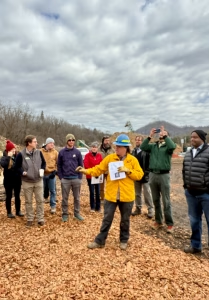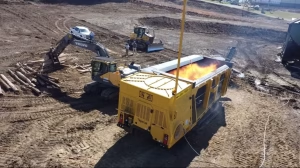North Carolina Districts Continue with Post Helene Recovery 09/30/2025
Earlier this year, Forestry Notes highlighted how Hurricane Helene reshaped the conservation landscape across western North Carolina. The storm left a lasting mark on forests and watersheds, with more than 187,000 acres damaged in the Nantahala and Pisgah National Forests and hundreds of miles of roads and trails blocked by debris. That coverage also noted how conservation districts, including Mecklenburg Soil and Water Conservation District and the North Carolina Association of Soil and Water Conservation Districts (NCASWCD), were elevating biochar as a practical tool for recovery and long-term resilience.
 That work is now moving into implementation. The Haywood Soil and Water Conservation District, in partnership with the Southwestern North Carolina Resource Conservation and Development Council, has secured a $1 million award from the North Carolina Department of Environmental Quality to pilot mobile biochar production in western North Carolina. The pilot will convert storm-damaged woody debris into a soil-enhancing product for farms and watershed restoration, creating a local outlet for low-value timber and reducing pressure on limited landfill capacity.
That work is now moving into implementation. The Haywood Soil and Water Conservation District, in partnership with the Southwestern North Carolina Resource Conservation and Development Council, has secured a $1 million award from the North Carolina Department of Environmental Quality to pilot mobile biochar production in western North Carolina. The pilot will convert storm-damaged woody debris into a soil-enhancing product for farms and watershed restoration, creating a local outlet for low-value timber and reducing pressure on limited landfill capacity.
The state has also directed $2 million to Haywood Waterways Association to accelerate debris removal and ecological restoration across the Pigeon River watershed. The effort will target stream blockages, stabilize eroding banks with native plantings, and coordinate work across jurisdictions to improve water quality and reduce flooding risk for residents countywide. Together, these investments advance Helene recovery while strengthening resilience to future storms, lowering wildfire risk by removing hazardous fuels, and improving soil health on agricultural lands.
 These steps also reflect the statewide approach that NCASWCD and partners have advanced since Helene. Work is underway to align biochar with cost share and technical assistance through NRCS and the NC Division of Soil and Water Conservation, and to expand cross-boundary restoration through Good Neighbor Authority with the U.S. Forest Service.
These steps also reflect the statewide approach that NCASWCD and partners have advanced since Helene. Work is underway to align biochar with cost share and technical assistance through NRCS and the NC Division of Soil and Water Conservation, and to expand cross-boundary restoration through Good Neighbor Authority with the U.S. Forest Service.
The emphasis remains on locally led action that scales through coordinated partnerships.
To learn more, you can read the full announcement here.

